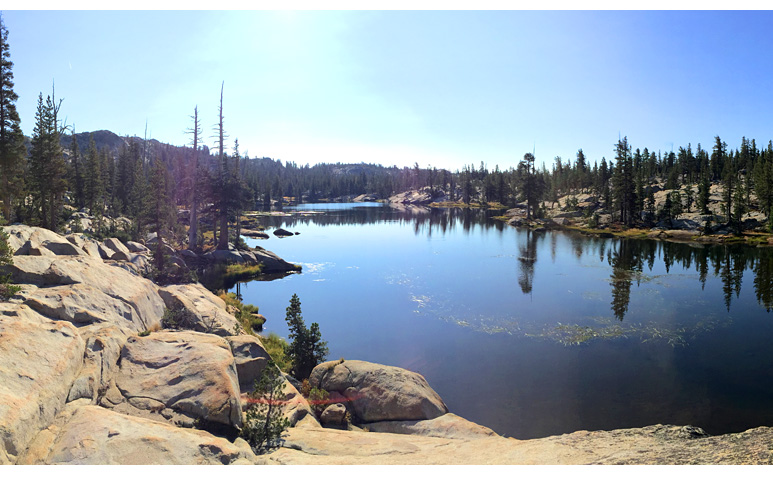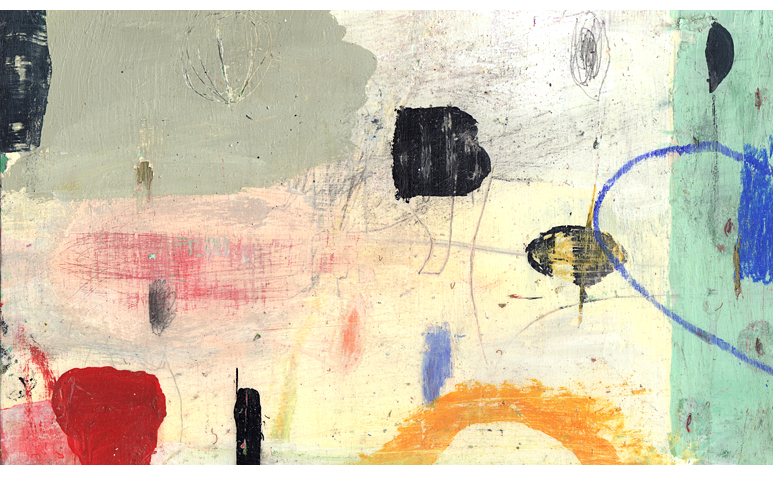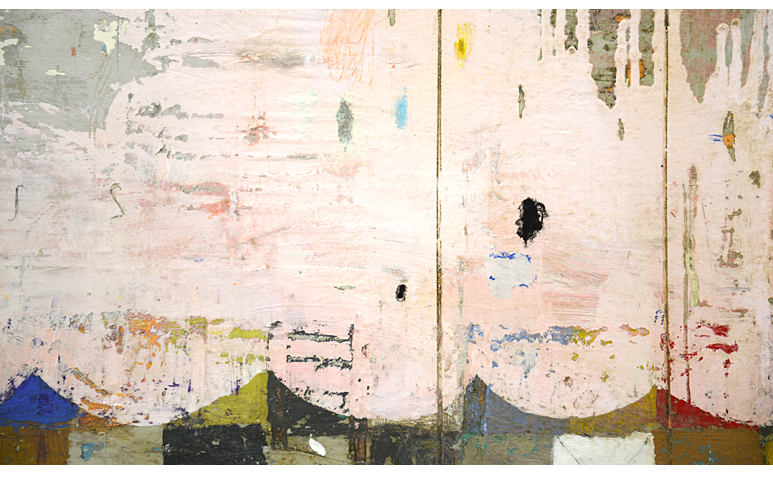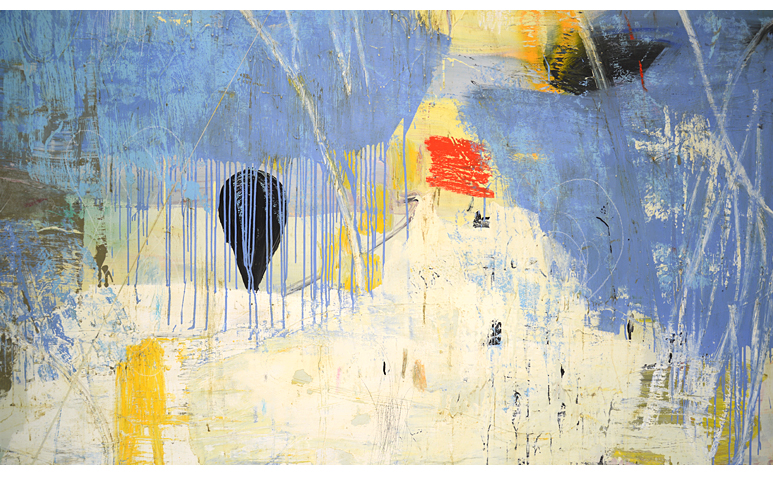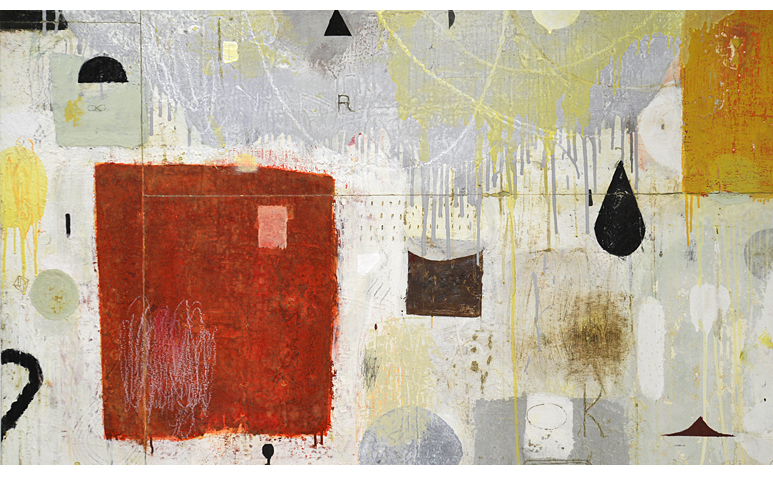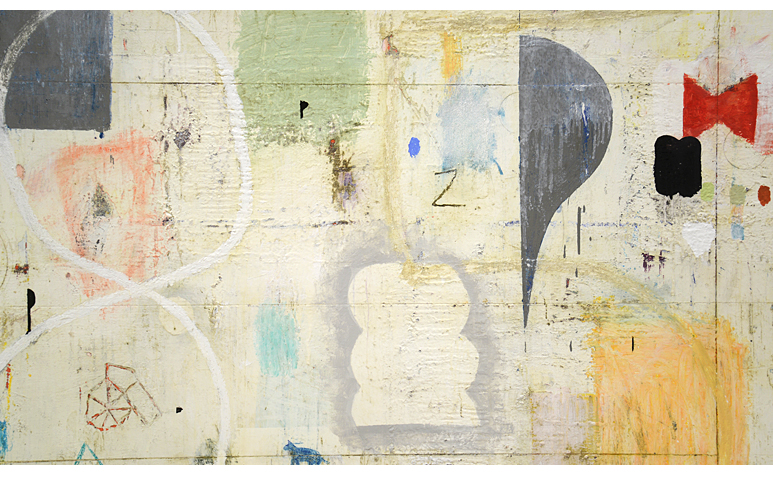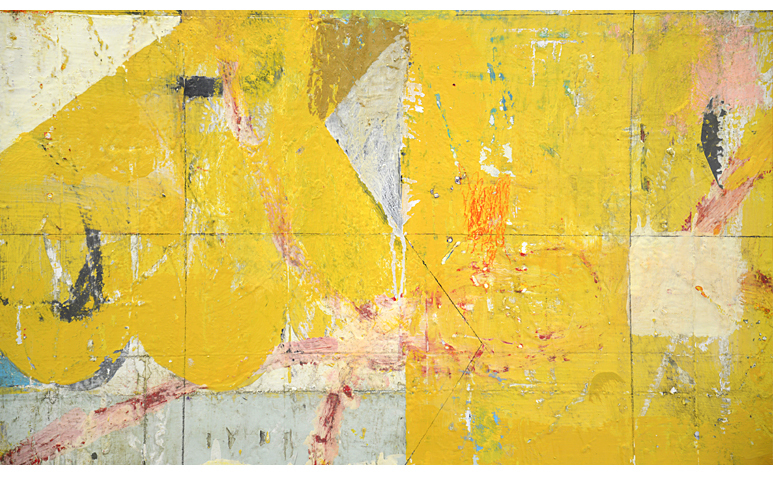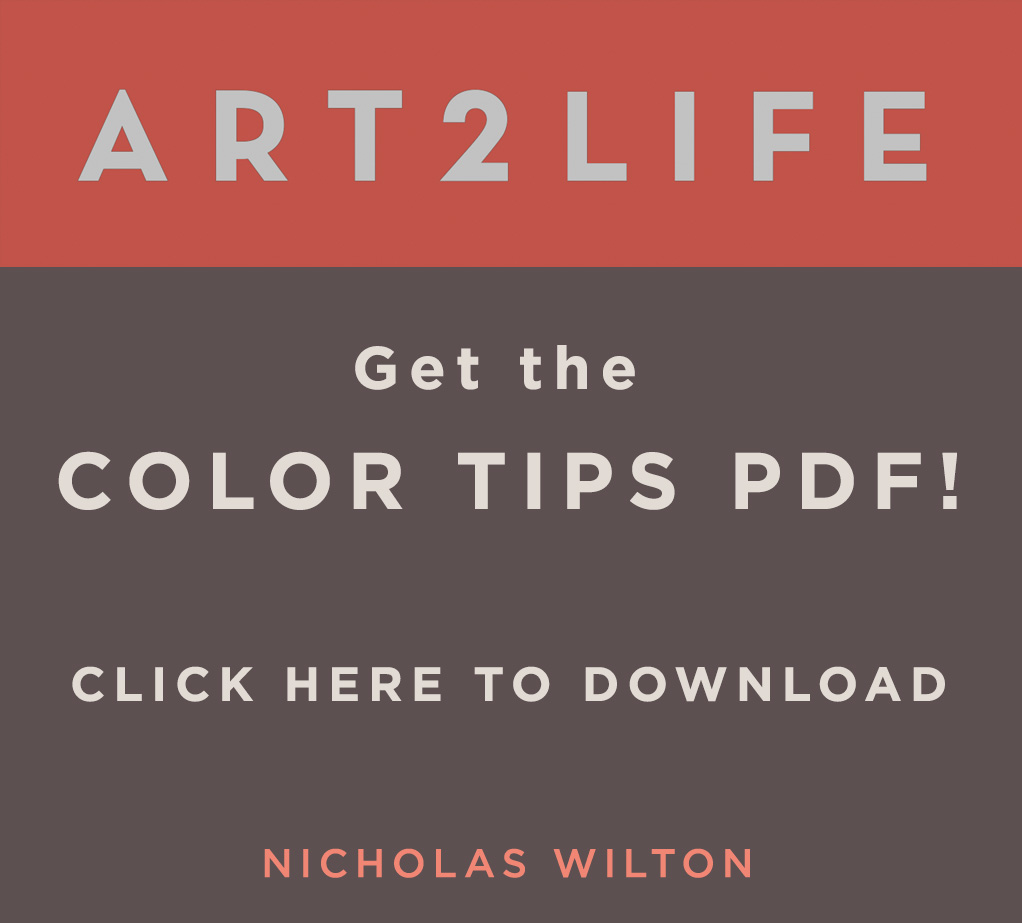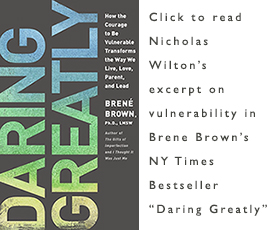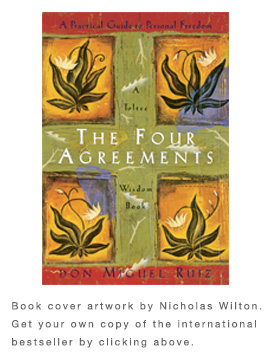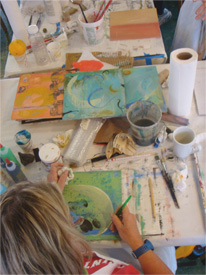How to Make your Art Extraordinary
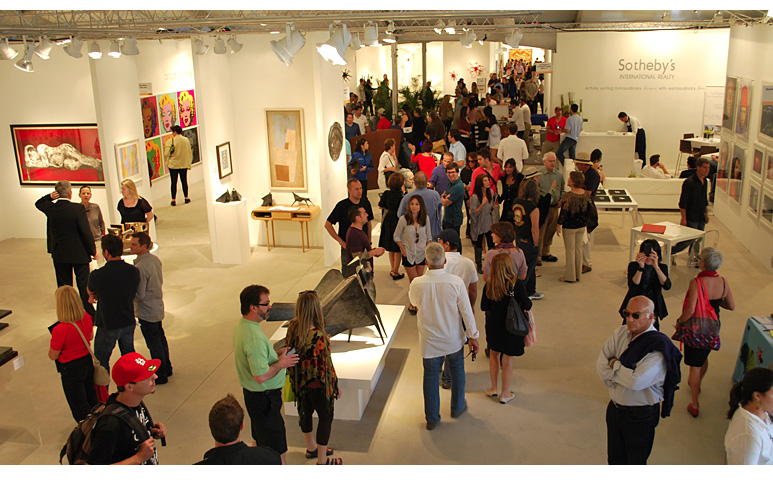 Art Miami 2012. Courtesy Art Miami, LLC.
Art Miami 2012. Courtesy Art Miami, LLC.
I love going to Contemporary Art Fairs. These are almost like the trade shows of contemporary art. There are paintings and galleries from all over the world. There are a zillion different kinds of paintings, photographs and sculptures strewn through baseball field size buildings with thousands of artists, buyers and art enthusiasts wandering amongst the displays. It often takes more than one day to see all the work.
It is inspiring to go. But it is especially so when you have some of your own work there. It allows the artist to see his or her art in context with everyone else’s. I remember when I went and finally came across my own work, for a second or two I hardly recognized it. After seeing everyone else’s art, I had achieved a measure of objectivity. Something that, upon later reflection, was incredibly valuable.
I stood there looking at my work, then back again at all the other work surrounding it – some good, some great and, of course, some not so good, but all of it provided context.
And then I got it – right there I had somewhat of an epiphany about what makes art – especially at these fairs, stand out.
There are basically three qualities, which I wrote down on the back of the Fair guide they gave me when I walked in.
1 The Art is Unique.
It is not hard to spot, at these fairs, which art is really drawing viewers in because today, people tend to wait in line to photograph it with their phone. They are voting with their phones and amazingly it is the same few paintings or sculptures that gain this attention. Without exception, this artwork being photographed is totally unique and unlike anything else surrounding it. I cannot stress enough how consistently work that is different and unique almost triggers human beings to want to engage. People are simply drawn to what makes them feel something they haven’t before.
2 The Art is Simply, Complex.
Another aspect I notice about remarkable work is that it is not accomplishing or showing a whole variety of ideas within the same work. It is not that the work is not complex; rather it is just that it looks relatively simple from a distance. The artist has chosen to clearly – and that is the operative word – not only say one thing but to do so very, very powerfully. Often there is just a couple of things going on, whether it is texture, shapes, color, line, etc., that are in contrast to one another. Interestingly, if something is communicated very simply, if the idea is clear, then suddenly there is an opportunity for quiet complexity to slip in beside this powerful, singular art statement and coexist. You end up with a seemingly simple, powerful visual that grows in complexity and sophistication the longer you look at it. “Something about this one…. I just can’t quite walk past it. Maybe I better just take a picture so I can hold it in my life longer.”
3 The Art Feels it is Made Without Trying.
Easier said than done, but work that rises to the surface at these fairs does demonstrate the artist’s mastery of their chosen materials. The artist doesn’t have to necessarily master their materials but at the same time the materials cannot be the master of the artist either. In other words – and this can be subtle – the viewer should not be able to feel tentativeness in any way on the part of the artist when using their chosen materials. We want to feel a direct connection between the artist and what they are thinking or doing. Seeing marks that are only half committed, or the evidence of materials that are overly controlled out of indecision can often be a barrier for the viewer to really get the impact of what the artist was trying to say. When the Art looks like it has been made without excessive effort, then we get the sense as viewers that this particular artist has these materials so down that she can spend her attention and focus on giving us a super potent distillation of who she is and what she is communicating as an artist, above and beyond the materials. That is truly a gift for a viewer and as such, whether people understand why or not, they are drawn to the work.
There is the tendency to try and game and figure out what makes people become attracted to certain kinds of art. Then, once known, we could just do this particular kind of art and all would be good. Thankfully, making art, as most of you know, is not something you can perfect and duplicate to have home runs every single day for yourself or anyone else for that matter.
But there is one overarching idea that all these qualities, aspects of powerful, highly desirable work, all seem to gather beneath.
And it is this:
Art that can become as truly unique as the individual artist making it will engender a feeling of aliveness in the viewer. And this feeling, this sensation for 99 percent of human beings walking around the planet is highly desirable, enticing, and inspiring.
In gratitude, Nicholas
PS This post happens to be going out the same day as the 2016 Mentorship Invitations! Admission will be closing in less than a week so if you ever wanted your Art to become more like you, then click here for the Mentorship Invitation and Application it will be emailed to you today.
Art, Life and a Fish
I just was backpacking with my youngest nineteen-year-old daughter, Hannah, high in the Sierra Mountains. We spent most of our days walking through high alpine forests, massive expanses of granite punctuated by startled deer and once, even a large, scurrying prairie dog, although we couldn’t be completely sure.
Every day we hiked to a new remote mountain lake, carrying all our food, shelter and kitchen stuff on our backs. In contrast to these effortful mornings, we would spend, upon arrival, pretty much the rest of our day sitting upon large, quiet boulders that bordered these serene and impossibly blue lakes.
To have multiple hours to just sit and watch the shadow patterns of the trees upon a lake change as each hot day drew to a close was such a nice break from my normal routine of driving in traffic or just trying to be always as productive as possible.
There just was simply nothing that needed to be done.
The conversation meandered for hours, naturally around all things contained in the relatively new life of a 19-year-old daughter and those of her father. The subject of writing in college came up which lead to art making in general. We spoke about how, even though you can’t see what you might do in your life, what will inspire you, move you, that something always appears.
Something will break the stillness, the quietness of your day, your life, and awaken you.
I spoke about this blog and how I never know from week to week what I am going to write about. However, something always comes along that holds a glint of inspiration. Something in the week will inevitably sparkle.
It is like this with making Art too. Something just always happens that can turn an afternoon of making art from effortful to extraordinary.
I was considering this idea, staring out at this very still, calm landscape not quite sure how to say what I was feeling when Hannah perfectly summed up the loose ends of my thoughts by so eloquently saying, “I just love to be around things that remind me of my smallness.”
I think this is really at the heart of it. We probably are much, much, smaller than our life. Maybe we can’t really control all that we hope we can. And maybe this is a good thing. Maybe our art, our life, is actually going to work out anyway. Maybe the enormity of our life and all that swirls around us, whether it is what we are trying to make in our art, or for our dinner or even what we might have to do that seems hard and scary doesn’t have to be.
Maybe we are being carefully held, swaddled and surrounded by a huge life that only will reveal to us just what we need, just when we are ready. You merely have to wait and be paying attention, to see. There is no small measure of trust involved. Faith really.
I don’t always know this. Mostly I am too busy to remember. But when I do I feel calmer and more hopeful.
The hours passed that afternoon in unbroken stillness until suddenly, a fish jumped right before us, breaking the glassy stillness of the lake. It startled both of us. My heart skipped a beat and I knew without even looking at my daughter that she was smiling too.
In gratitude, Nicholas
Why Your Next Big Thing Will Be Successful
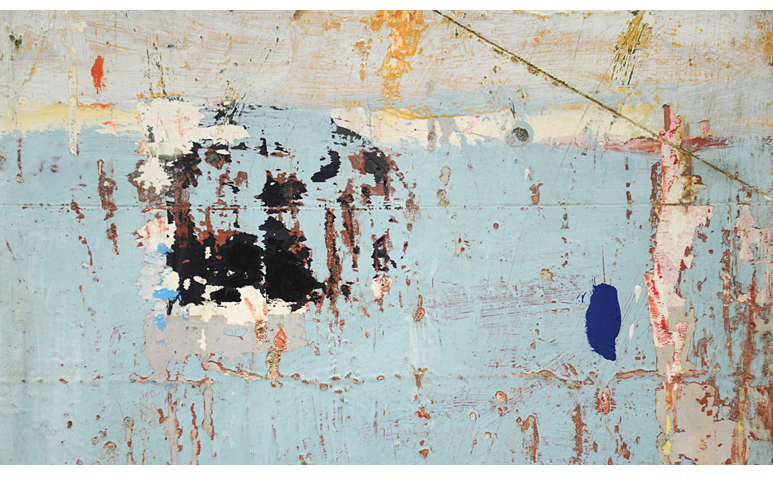 I have been making art my whole life. I spent one summer in Hawaii when I was 18 cooking in a restaurant. Other than that I have never held a job. I have always made art. So I have gotten used to the ups and downs of working for myself. I have had to find ways to learn anything new I wanted to pursue. If I wanted to teach workshops I had to figure out how one goes about this…if I wanted to use oil paint I had to learn this too. When you start adding all the things up a creative might need to know it can feel daunting. Who knew we needed to learn about websites, photography, social media, pricing, galleries, leases on studios and time management? All I wanted to do was make art!
I have been making art my whole life. I spent one summer in Hawaii when I was 18 cooking in a restaurant. Other than that I have never held a job. I have always made art. So I have gotten used to the ups and downs of working for myself. I have had to find ways to learn anything new I wanted to pursue. If I wanted to teach workshops I had to figure out how one goes about this…if I wanted to use oil paint I had to learn this too. When you start adding all the things up a creative might need to know it can feel daunting. Who knew we needed to learn about websites, photography, social media, pricing, galleries, leases on studios and time management? All I wanted to do was make art!
Every time I start something new I am reminded of how challenging it can be. There only is so much energy in the day. Often the thought of taking on any new learning can feel exhausting and inhibit us from beginning. How can I possibly do one more thing if I am already tired?
Well luckily, and this is something I often forget, the starting of something new, an infusion of new learning in your life, provides just the right amount of extra energy you need to succeed.
Here are the three primary sources of energy and where to find them so that you can accomplish that next big thing.
New gives you energy.
There is nothing like starting something new to wake you up. If you are slightly outside your comfort zone then growth is occurring and this is energizing. It might be scary but it is also energizing. This energy boost is used to get you through the beginning phase of starting something new. You merely need to begin.
Small, successful steps
Sometimes a new project or direction can be overwhelming. It can often feel this way when trying to accomplish too much, too soon. It is essential to take small steps and learn to really appreciate incremental learning. If, at the end of the day, you have accomplished one small step then congratulate yourself. Take the energy from the small wins so you may continue to achieve them every day. After so many years of taking on the next big thing, I have finally learned to feel pretty satisfied if in my day I merely “move towards” in any way, my long-term goal. If you can perceive your process of getting there as successful, then more likely than not, you will be.
Tell others what you are doing
When you share with friends or colleagues what you are attempting to do several positive, energizing things happen. Firstly, that person often will have words of encouragement or some insights that might be helpful. Their reaction is often positive because everyone wants to change aspects of their lives or their careers and by your attempt to change yours, offers them inspiration to do the same. You have, in fact, given them something quite valuable and in return they are looking for ways to help you.
The next benefit is really the most important one. By actually speaking out loud what it is that you are trying to accomplish, you are in many ways articulating to yourself the outcome that you desire. From my experience, I see how this clarification of intention has a way of bringing your desired outcome more easily.
I don’t know why this is so, but it is almost as if the universe is listening to those who are willing to speak their dreams and desires clearly. Once heard, people show up, alignments happen and life in general just seems to send help your way.
This mysterious wonderful aspect of life is often buried under the to do lists, and forgotten in the monotony of the day to day. Stepping forward with some degree of faith to try to do something new brings this somewhat elusive, beautiful truth to the forefront again.
And perhaps, for just this fact alone, it might be time to try, today, to start that next big thing.
What is your next new thing and have you begun?
In gratitude, Nicholas
What You Can Eat to Energize Your Art Practice
It takes a tremendous amount of energy to make art. I do my best work in the morning. I start early. What really helps me maintain my energy during this time is what I eat for breakfast. I am not an expert on diet but I can say from my experience that having a smoothie for breakfast totally sets my day up. This is not just a drink – it’s a meal. It is loaded with super foods, fresh greens, vitamins and minerals. If you sometimes feel like you are running low on energy in the studio you might consider starting your day with a green smoothie. I literally couldn’t pull off my busy life without them.
Here are the 3 reasons why:
It’s fast
I have everything I need all prepped in my freezer and refrigerator. I literally can make and clean up a 24 oz. smoothie in about 5 minutes.
It’s Sustaining
I drink a 24 oz. smoothie and I am good to go till lunchtime. This particular smoothie I make is the most, by far, nutritious meal I eat in my day. I don’t need to drink coffee or tea in the morning (or the afternoon) anymore. I feel super clear but most importantly very energetic while I am making art.
It’s Portable
I pour the smoothie into a 24 oz. container with a lid that has a tiny hole for a straw. I drink my breakfast as I go about my morning whether it is reading, walking my dog Maizy or even driving to the studio. I love to go wherever I want while I am having breakfast.
I am interested and continuing to learn about nutrition and diet as I see what a difference it is making in my life and art, so I spend time perusing different sites on the internet for information and recipes.
One of the best resources for general info on smoothies, blenders, and over-all nutrition I have found online is Robyn Openshaw’s site www.greensmoothiegirl.com. Her knowledge is exhaustive and from all my research I feel she has one of the best lines on total health. She also sells and reviews blenders, food related products and has great tips and tricks on maintaining optimal health, easier.
Here is my basic smoothie recipe.
The Art2Life Smoothie Recipe:
3-4 frozen strawberries
3-4 frozen 1″ pieces of banana
1/3 C frozen blueberries
1 C fresh organic spinach
1 C almond milk unsweetened
1 C water
3 tbs frozen orange juice concentrate.
1 tbs goji berries
1 tbs ground flax seed (raw)
2 tsp. bee pollen
1 tbs Organic cold pressed flax seed oil
1 tbs chia seed
1/2 tsp. coconut flakes unsweetened
Makes approx. 24 oz. (3 cups)
Does what you eat matter? How do you sustain your energy for your Art and Life?
In gratitude, Nicholas
Change Your Thinking to Better Sell Your Art
There are many challenges facing artists but one of the most pervasive, especially with artists who are just beginning, is selling their art. Whether you sell your work or not does not matter, of course, although many people do want this outcome.
I know I did when I started. I still do, as I could not afford to make art otherwise.
Part of the problem is the actual making of art doesn’t always leave you feeling particularly bullish about the value of your artwork. If you are like me, the better the work ends up being in hindsight, the more insecure, the more unsure I was when I finished it. Sometimes I just know, but often if I have really broken through—which is what I am trying to do all the time, I wont necessarily recognize the work as particularly strong. I just can’t see it objectively. There is vulnerability involved in making authentic artwork. It just doesn’t seem to build your self-esteem, your confidence up. It is hard to put a high price on something if you feel slightly unsure. As a result artists frequently undervalue their own work.
Figuring out the money part is challenging. I would like to offer a few lessons I have learned that have helped me in this aspect of my career.
Finding your price point
Your work will sell at a certain price. (And it is crucial to put your art in front of the right audience, but leaving that aside for now.) However, generally speaking if you haven’t sold your work before, you need to find that price. Sometimes we can price our work too high. In a way this is good, for the artist should value their work. Erring on the side of too high seems reasonable. However, if the outcome is few or no sales then the artist is left with a bit of an emotional tide to swim against when setting about making more art. It is hard in the face of no sales, even though this has no relationship to how good you should feel about your art, to plow ahead and make 10 more of what you just didn’t sell. Far better to have sold some, even if they sold for a bit less than you would of liked, because the net resulting feeling is positive and most importantly you are more motivated to make more Art! So don’t worry, especially in the beginning, if you price your art on the low side. Prices generally can only be raised because the art sells, so don’t let a too high price stop sales, especially in the beginning.
There is more where that came from.
If your objective is to sell your art, especially when starting out, it is important to re remember this idea about abundance. We make art and we put all the care in the world into it. We micro manage every aspect of its birth. However once it leaves us and heads off to a gallery or is for sale then we need to lighten up about its future. Obsessing too much on getting exactly what you want and not a penny less is, in my opinion, not where the energy of the artist is best spent. If you end up selling it for what might seem a bit less than what you would like then first congratulate yourself on selling something – this alone is no small feat – and then instead of bringing in negative thoughts around this positive occurrence, use the positivity, your good fortune to begin another piece of art. Selling Art is partly perpetuated by simply selling art. Keeping your mindset positive and inspired so that you can make more art is key.
Share your success so you can have more.
I hate to say it but one of the key human motivators is money. I know it seems better to keep all the income from possible sales of your artwork, in other words, cut out all those middlemen, galleries, designers etc. In the short term this might be the way to go. It certainly feels better keeping all the profit. But if the selling of your art, can allow other people to make money, then you suddenly have more than just you interested in the sale. When you can make it easy and possible for others to profit from your success, you will have a thriving business. It is hard, but try to think of all those percentages you might share with others as an investment in your career. Try not to think of what you are giving away, but instead think of all you can create in the future with others helping you to sell your artwork.
The idea that we can create something out of nothing, over and over and over again is important to remember when dealing with the marketplace. We, unlike most businesses, can generate product – our art – out of virtually nothing, over and over again. The supply is endless and if you are like me, you wouldn’t want it any other way. In my opinion the deck is stacked in our favor. Don’t let the tiny side show of selling your art distract too much from the awesome creative endeavor of making your Art.
What has your experience been in selling your work? How do you approach this aspect of your art practice? Please share your thoughts and comments below.
In gratitude, Nicholas
How Your Dreams Come True
Do you ever feel like starting all over? I love art making because in a way you get to start over every time an artwork is finished and another is begun. But I am also talking about big changes such as switching careers, or doing something entirely different or starting a new business, perhaps in an area you are unfamiliar with. The crazier, the bigger the dream is, however, the less one tends to talk about it with people. If it seems outlandish to you what will it seem like to other people?
So the really big ideas, the really big desires, left unspoken, can often go quietly dormant. I think about this fact all the time. Lately I have been dreaming about setting up a sailboat with an internet connection so I could sail to tropical islands, stay connected with all of you via satellite and keep making art in different locations.
I also want to go see the gorillas in Uganda. I would like to do enormous murals on the sides of buildings. Those are my top three right now. What would you do if you could do anything?
These thoughts are fun but daunting. First of all, I am not entirely sure I would be happy doing any of them. Secondly, I have no idea really how to get from here to there. It just feels overwhelming, and after thinking about it for 10 minutes isn’t it way easier to go to the studio as I do every day and make Art? Isn’t that challenging enough?
After all, not so long ago, being able to make Art full time was just a dream of mine. I am so glad I didn’t shelf that one. So then, how does one go from A to B? How do Dreams become real?
I don’t entirely know, but from pulling off a few in my life I am beginning to see a pattern in the manifestation of dreams.
Write them down and they begin to grow.
I have a little ritual I do at the beginning of the week where I write down big ideas I am thinking about for the present and for the future. In doing this and reviewing these entries every week it puts these ideas back in the forefront of my thinking. Every week I just keep seeing them. Over time they become familiar and the ones that resonate stay and the ones that do not, fade away. The ones that remain tend to grow in importance.
Synchronicities as Cheerleaders
Like when you learn a new word and then for several days after you keep seeing that word, putting ideas and dreams repeatedly in the forefront of your thinking invites synchronicities and alignments into your day that seem to almost naturally grow these ideas. For example, once I write down I want to go see the gorillas in Uganda, I might meet someone by coincidence that just returned who encourages me to do the same. I do not understand why this occurs in one’s life, but I am just reporting my experience. Begin to articulate a dream and it begins becoming a reality. The universe almost sends things your way to help you on your path.
Leveraged Dreams are actualized quicker.
So sailing around the world, blogging and making art and somehow uploading it to the world via a satellite while exploring the South Pacific does seem a tad unrelated to what I am currently doing…driving a car, often in traffic to a studio and spending way too much time on Facebook.
However, pieces of that dream or that idea – the idea of being somewhere tropical or being able to work remotely far away from my studio – are not. So maybe instead of just drastically changing everything, I could move towards it by just simply talking to people about it. Maybe I could take my next lunch break and walk around the harbor in Sausalito (My studio is next to a harbor – no coincidence) and look at the sailboats that are anchored offshore and imagine what it would be like. I could write about it a little in a blog post perhaps.
The idea is to take steps towards your big goals and dreams from a situation that you have already created inroads into. It wouldn’t be that hard to make my whole business scene remote, as I am halfway there already. Since I already write a blog that allows me to talk to a lot of people, maybe if I wrote about a dream of mine here, someone reading might say something helpful. Who knows?
I do know, however, that never saying out loud what you truly want or desire is not helpful in the actualization of those desires.
I think it all boils down, once again, to how we think about everything. Is our life static? How hard is it actually to change everything? Is it just hard or is it just our thinking that limits us?
Marianne Williamson in her wildly popular book “The Law of Divine Compensation” eloquently sums this idea up….
“It is not our circumstances then, but rather our thoughts about our circumstances, that determine our power to transform them.”
So maybe jot down what you want to happen or better yet tell someone else or tell your dream in a comment below. From my experience it is the first tiny step towards allowing your dreams to come true.
In gratitude, Nicholas
How is it Going?
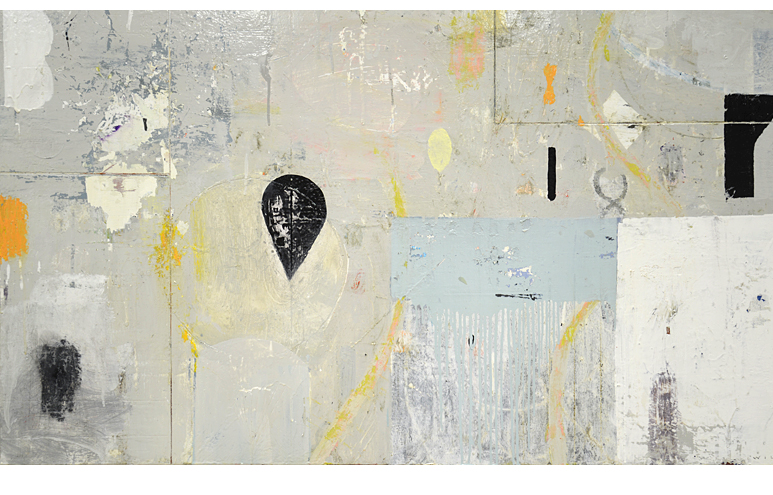 I am often asked how my career is going. There is a real curiosity especially amongst friends and acquaintances that are not artists. They just cannot fathom what it must be like to be doing something all day long that is entirely self-generated. There are no deadlines, except those we create ourselves, there is no certain time we have to arrive at the studio and hopefully there is no one overseeing our progress. It is, in the end, just you holding onto a handful of ideas, hunches and dreams. There is some security, some assuredness gained from looking back at what we have made in the past, but most of the challenge, most of the uncertainty drifts around what we might possibly be making in the future. It often is not clear.
I am often asked how my career is going. There is a real curiosity especially amongst friends and acquaintances that are not artists. They just cannot fathom what it must be like to be doing something all day long that is entirely self-generated. There are no deadlines, except those we create ourselves, there is no certain time we have to arrive at the studio and hopefully there is no one overseeing our progress. It is, in the end, just you holding onto a handful of ideas, hunches and dreams. There is some security, some assuredness gained from looking back at what we have made in the past, but most of the challenge, most of the uncertainty drifts around what we might possibly be making in the future. It often is not clear.
So when asked from the outside, “how is it going?” if I were entirely honest I would say I actually am not sure. The movie is still playing. I don’t have a clue how all of this is going to turn out.
So I tend to speak of concrete things from the recent past- maybe a show or a commission I recently completed that – looking from the outside – makes the life of being an artist appear more like a job. I go in to the studio, people order these paintings and I produce them and because there is only one of me, the supply is limited so over time the prices go up. And yes, I am so fortunate because unlike everyone else driving to work in traffic at 8:30 am, I am sleeping in or waiting around in a beautiful setting for the muse to strike. That pretty much sums up how the outside world likes to paraphrase what we do. What’s funny is that I just kind of play along with this and help create this narrative.
But there is one problem. It isn’t true. Does it make sense, just because it is too complicated or daunting, to describe what we do more truthfully? I go to great effort to make art that feels authentic and truthful, so why describe the process of making it so simplistically?
But what can I possibly say that is truthful and will be understood by those who have conference calls and management meetings? What is the universal thing that connects all of us, whether we are artists, investment bankers, business owners, stay at home mom or dads, schoolteachers or even circus performers?
The one that easily pops to mind is money. But this isn’t entirely accurate. To try to describe the activity of art making from primarily a money perspective is almost laughable.
There must be something else. And then it hit me.
The one thing we all need, the one thing we all cherish at the end of the day is Learning.
It is what we are all after in life. We are learning about our selves and each other. We are learning about tiny pieces of the universe illuminated by the particular activities we spend our time doing.
It is also, when you really think about it, a pretty good yardstick of how well you have lived, if at the end of your life you can say that you learned so, so much. The knowledge we gain about each other, the world and ourselves is, in the end, how positive change occurs. And not just small incremental personal change but also massive world change. This kind of change is breathtaking and offers us purpose. It is the kind of change that makes life worth living.
So now when people ask, how is it going? I still mention the gallery show but put way more emphasis on what is actually happening in my studio and as a result, my life. I simply say, what I am mostly excited about these days, what I am so grateful for, so incredibly happy about is that I am learning.
I am learning more than I ever, ever dreamed possible.
In gratitude, Nicholas
5 Ways to Thrive as an Artist
Sometimes being an artist can feel hard, while other times it can feel inspiring and joyful. In trying to keep things more the latter, I try to keep the following five points in mind. All of them are available at anytime and there is no cost involved. I believe they all contribute significantly to building buoyancy, productivity and joy in one’s art practice.
1 Show Yourself
Show yourself. Let people see what you have made. Show your enthusiasm generated by your art. In return you will receive additional energy and illuminating feedback that will help sustain your momentum from those around you.
2 Be Generous
Be useful and helpful to other artists. Do not be concerned with being secretive about your art. No one can make work like yours if you are being authentic.
3 Stay Connected
Your success, energetically, financially and even spiritually is directly connected to those that support and follow your artistic journey. Never lose connection with those that express interest and resonate with what you are doing. Cherish them.
4 Be Discerning
It takes a tremendous amount of life energy and optimism to sustain your creativity. Do not spill any of it on people or situations that you already know are not in alignment with your art or you. Conserve all your energy for situations and people who support what you are doing.
5 Remain Exceptional
Your artwork is a visual expression of your authenticity. To have the courage to listen and show what is within you to the outside world is rare and tremendously brave. Making your art makes you feel more alive but also has the same effect on others. This is why people will desire and, even sometimes, buy your Art. Your art, if it is authentic reminds them of their aliveness. Your art is your gift to the world and you are the only one who will ever be able to create it. It is simply an opportunity of a lifetime.
Keeping these 5 points in mind will help keep your art and you steadily on course. In the end it might not be about arriving at any particular place with your work but more importantly how it felt as you journeyed towards it.
What guides you in your work? How do you keep yourself inspired?
In gratitude, Nicholas
How to Write a Great Artist’s Statement
I received a question from an artist the other day about how to write an artist’s statement. I obviously can’t comment on what anyone can say about his or her work as everyone’s work is different; I do however, have some observations and guidelines that I use for myself regarding how I write about my work. These might be helpful, especially in relieving some of the anxiety that seems to hover around creating an artist’s statement.
#1 It is about the work.
If your work was unbelievably strong and your artist’s statement only was “See my Art”, I seriously don’t think it would hurt your art career. However, if your Art is rather weak then no clever artist’s statement is going to convince anyone otherwise. In other words, the art trumps the statement. So remember, this statement is pretty puny in comparison to your actual Art. Keep it in perspective. It need not be a big deal.
#2 Write like you Speak
Most of the artist’s statements that I read I honestly do not understand. There seems to be this need for artists, when they are talking about their work, to sound utterly different than they normally do. They use new complex vocabulary words and phrases that leave you marooned in ambiguity. The end result is that you feel alienated from the artist because you don’t understand their language. Art is about connection. Think about the artist’s statement as another way to connect with people. Appearing smart and important because nobody understands you is an accomplishment, but I am not sure it will serve your art career. Keep it simple, but most importantly keep it like you by using your ordinary voice.
#3 When in doubt talk about how it feels.
Your work is personal, so your artist statement can be too. You don’t need to have all the answers, all the “whys” of why you make art, figured out. There doesn’t need to be some higher order that your work fits in to justify its existence. It is completely valid because you made it. Period. When I get tongue-tied I go back to how my art feels or what is the feeling I am after in making the work. This keeps it personal and nobody can argue with how or why something makes you feel a certain way. You simply cannot go wrong with writing from a place of authenticity. It works in making Art as well as writing about your Art.
I think it is important to be able to communicate in another way besides visually. The artist’s statement can provide people with an alternate route, a different point of reference to better connect with your work. If you think about that someone, the person who just is so curious about what you do that they are looking everywhere and at anything you have created to glean just a bit more understanding about your work, then this might keep you on track better. Try and be helpful. Try and keep it real and remember it is not just about you… When you are creating your statement, think of this person and help them to better understand what you do.
What has your experience been with artist’s statements, both in terms of writing and reading them? Have you read any that resonate particularly with you?
In gratitude, Nicholas
Three Ways to Make Your Art Easier
Have you ever noticed in the beginning of making your art that everything feels easy and then, after working for a while it gets more difficult? You simply are not sure what to do next. Progress slows and then interest wanes. Being stubborn, I usually will just continue to try harder and harder. Sometimes this works, but more often than not, things just become messier, and I become more muddled. It is a part of making art that I find really frustrating.
Over the years, because I so dislike this situation, I have spent a lot of time thinking about it why it occurs. For me, it turns out this problem has nothing to do with what kind of materials I am using, what I ate for lunch or whether I am feeling confident or not.
It feels like I temporarily have lost my creativity. But how could that be? I finally figured out the problem. It has mostly to do with losing objectivity.
I define “objectivity”, in relationship to art making, as the ability to perceive the art you are making not just from the artist’s perspective, but also as the viewer, the person who is seeing the art for the first time. To wear both these hats is tricky, especially for the artist. We just get so immersed in the process of making the art that we simply lose this outside perspective. It is this outside view, however, that provides us with the ability to make a lot of the bigger decisions needed to move the work towards completion. Without it we can become lost in the minutiae of the process.
This was such a problem for me that I had to change the way I make Art. These three changes have helped me maintain objectivity longer and have lessened the occurrences of becoming lost along the way.
1 Work on multiples
I always work on several paintings at the same time. Switching to another artwork as soon as I start to feel my interest waning allows me to stay engaged in my process. Interestingly, once I embark upon a second painting with a completely different set of problems, this somehow allows me to better understand the problems of the first. When things get hard I just move on to another painting. I always have at least 3 paintings going at the same time.
2 Work in more intervals
I finally figured out I am way more productive, especially if things are not going easily, if I work for an hour three separate times, instead of working one time for 3 hours.
Having breaks, doing new things between the times I am making art allows me to come back to my art with a refreshed objectivity. I just never have enough time to feel bored in the process because I don’t stay too long. Objectivity is always strongest, for me, in the beginning, when I first return.
3 Experiment along the way.
I noticed that if I was really engaged in what I was making, that my decisions were not only better, but also more easily made. In other words, if things were happening in my art that were new and different for me I could better know what to do. My problems would seem to happen more when I was becoming bored from doing something I had done before. So in order to fix this I now make a concerted effort to spend some time experimenting in my process. I take way more risks and simply try to do new things along the way. I now know that not knowing what might happen next is an essential feeling that I just simply must frequently feel if I want to easily and consistently make art that I like.
Making Art is a process that is so personal and very nuanced. It can be super challenging or it can feel incredibly light and easeful. How do you maintain objectivity in your process? What helps you make the art you love?
In gratitude, Nicholas
